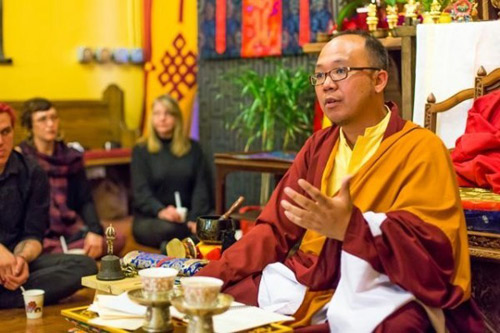
Like all medical doctors, traditional Tibetan physicians seek to reduce a patient’s suffering. However, the means of accomplishing that end are decidedly spiritual. In order to fully understand the Tibetan medical perspective, one must also understand the tradition’s Buddhist foundation. This unique melding of religion and medicine was the central focus of Dr. Hun Lye and Dr. Youlha Tsering’s presentation on “Tibetan Perspectives on Pathology and Wellness” at Malaprops Bookstore on Oct. 29.
In the Buddhist tradition, the concept of suffering is translated to the slightly more complex Sanskrit term, dukkha. “Dukkha is the existential problem that we all have,” explains Dr. Hun Lye, founder of Urban Dharma, a local Buddhist community in downtown Asheville. “Suffering is simply that underlying feeling that something is not right.”
The Buddha believed that all suffering stems from three causes or three poisons: desire, hatred and ignorance. All of these causes arise, says Lye, from “a fundamental lack of awareness of things as they are.” Tibetan medicine takes this Buddhist concept further and addresses the ways in which the three poisons effect both physical and mental health.
Traditionally trained Tibetan physician, Dr. Youlha Tsering, explains that physical and mental health cannot be separated. The emotional state of a patient and the physical state of a patient are “always related, always interdependent.”
Tibetan medicine — a synthesis of knowledge from the medical traditions of India, China, Greco-Arabic cultures and Tibet — recognizes three main energies at work in the body: lhung energy, tri-pa energy and bad-kan energy. Each energy has its own distinct qualities and corresponds to specific areas of the body as well as potential ailments. When these energies are out of balance, disease and suffering occurs both on physical and emotional levels. Both speakers agreed that in Tibetan medicine, more emphasis is placed on the cause of illness than on the symptoms of illness.
For example, Tsering might see a patient with a liver issue and, instead of immediately prescribing medicine to treat the symptoms, he might question the patient about his or her emotional state. This may seem bizarre to an American patient, but in Tibet, this interest in emotions would be quite common. Tsering explains that the energy associated with anger is located in the heart and liver. Therefore, many patients with liver and heart issues may also have issues with anger. “What is anger?” says Tsering. “What is the nature of anger? What is the function of anger? What is the result of anger? How does it affect the body and the mind?” These are all important questions within the Tibetan medical tradition.
“The treatment of the body is rooted in the understanding of the mind,” says Lye. “Some of the greatest doctors in the Tibetan tradition were basically monks and Buddhist practitioners.”
The talk was rounded out with a question-and-answer session where attendees asked about issues ranging from karma to breast cancer. To conclude, Lye pointed out what he perceives as the big irony in the West and within western medicine, saying, “We value individuality so much, but the solution seems to be a group solution, like one size fits all.” Asian cultures, he counters, are the “opposite.” People in Asia typically place less emphasis on the individual culturally, but when it comes to medicine and spirituality, there is much more of a “tailored approach.”
– Source : www.mountainx.com




